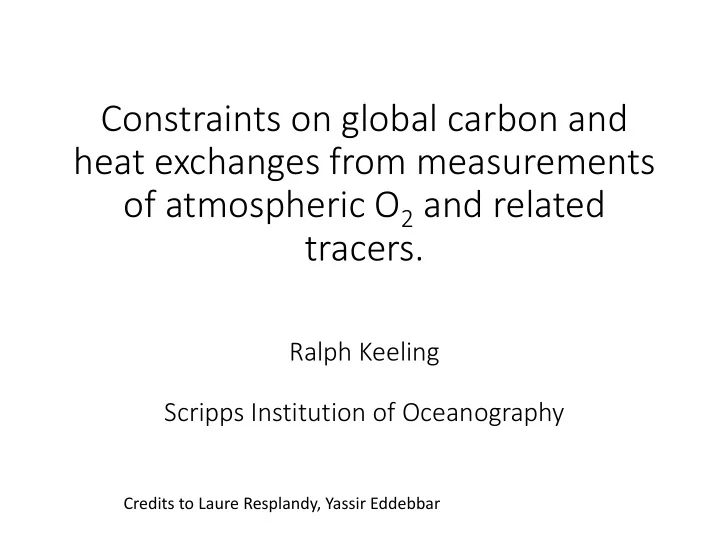

Constraints on global carbon and heat exchanges from measurements of atmospheric O 2 and related tracers. Ralph Keeling Scripps Institution of Oceanography Credits to Laure Resplandy, Yassir Eddebbar
Controls on atmospheric CO 2 increase Land Industry Oceans Plants 2- + H 2 O ↔ 2 HCO 3 - CO 2 + CO 3
Controls on atmospheric CO 2 and O 2 Land Industry Oceans Plants 2- + H 2 O ↔ 2 HCO 3 - CO 2 + CO 3
Scripps CO 2 and O 2 Sampling Networks Measurements of CO 2 Concentration and isotopes: 13 C/ 12 C, 18 O/ 16 O, 14 C Measurements of O 2 /N 2 ratio and Ar/N 2 ratio Archive of pure CO 2 extracted from samples
O 2 /N 2 and CO 2 trends − ( O / N ) ( O / N ) 2 2 sample 2 2 reference δ (O 2 /N 2 ) = 4.8 per meg ~ 1 ppm ( O / N ) 2 2 reference
Controls on atmospheric CO 2 and O 2 O 2 Heat Land Industry Biosphere 2- + H 2 O ↔ 2 HCO 3 - CO 2 + CO 3
CO 2 budget 2000-2010 (Pg C/yr) Land Use “Residual Sink” Fossil fuel emissions 7.8 ± 0.6 Land use emissions 1.1 ± 0.8 Ocean Total Sources 8.9 ± 1.0 Fossil-Fuel Burning Atmosphere 4.0 ± 0.2 Atmosphere Ocean sink 2.3 ± 0.7 Residual land sink 2.6 ± 1.2 Total Sinks 8.9 ± 1.0 SOURCES SINKS IPCC AR5
Controls on atmospheric CO 2 and O 2 O 2 Heat Land Industry Biosphere 2- + H 2 O ↔ 2 HCO 3 - CO 2 + CO 3
Controls on atmospheric CO 2 and O 2 Anthropogenic Climate CO 2 uptake fluxes O 2 Heat CO 2 CO 2 Land Industry Biosphere 2- + H 2 O ↔ 2 HCO 3 - CO 2 + CO 3
Controls on atmospheric CO 2 and O 2 Atmospheric Potential Oxygen APO ~ O 2 + CO 2 = APO ff + APO anth + APO climate Anthropogenic Climate CO 2 uptake fluxes O 2 Heat CO 2 CO 2 Land Industry Biosphere 2- + H 2 O ↔ 2 HCO 3 - CO 2 + CO 3
O 2 , CO 2, and APO trends O 2 CO 2 APO ~ O 2 +CO 2
APO constraint on warming APO climate APO anth APO ff Ocean warming calculation: Average trend 1.20 ± 0.35 per meg/yr (1.2 per meg/yr) (0.87 per meg/10 22 J) = 14 ZJ yr -1 (1 ZJ = 10 21 J)
Increase in global ocean heat content 14 ± 4 ZJ yr -1 14
Establishing the 4 ocean model simulations: GFDL, CESM, IPSL, UViC connection between APO climate and ocean warming
Manuscript in Review: L. Resplandy, R. F. Keeling, Y. Eddebbar, M. Brooks, R. Wang, L. Bopp, M. C. Long, J. P. Dunne, W. Koeve, A. Oschlies, “Quantification of ocean heat uptake from changes in atmospheric O 2 and CO 2 composition”, Nature Geosciences
Measurements of Ar/N 2 Quantifying global ocean heat content changes
Measurements of trends in Ar/N 2 ratio δ( Ar/N 2 ) (per meg) = (Ar/N 2 ) sample ( - 1 ) x 10 6 (Ar/N 2 ) reference
Measurements of trends in Ar/N 2 ratio (4.0 ± 1.6 per meg/decade) (2.57 per meg/100 ZJ)(10 year/decade) = 15 ± 6 ZJ/yr
Global energy balance equation Heat α∆ T s = G Storage + IR to space Radiative forcing (GHG) due to T s increase 1/ α = climate sensitivity o C per W/m 2 of forcing, or o C per CO 2 doubling
Larger Heat Storage implies higher climate sensitivity • IPCC AR5 sensitivity range +1.5K to +4.5K per doubling Used ~8 ZJ/yr for heat storage • Upwards revision of heat storage by 5 ZJ/yr increases lower bound from 1.5 to 2.0 K per doubling.
Thank you
Temperature ( o C) 0 10 20 δ( Ar/N 2 ) sensitivity 3.9 2.6 1.8 (per mg/ 100 ZJ)
Recommend
More recommend